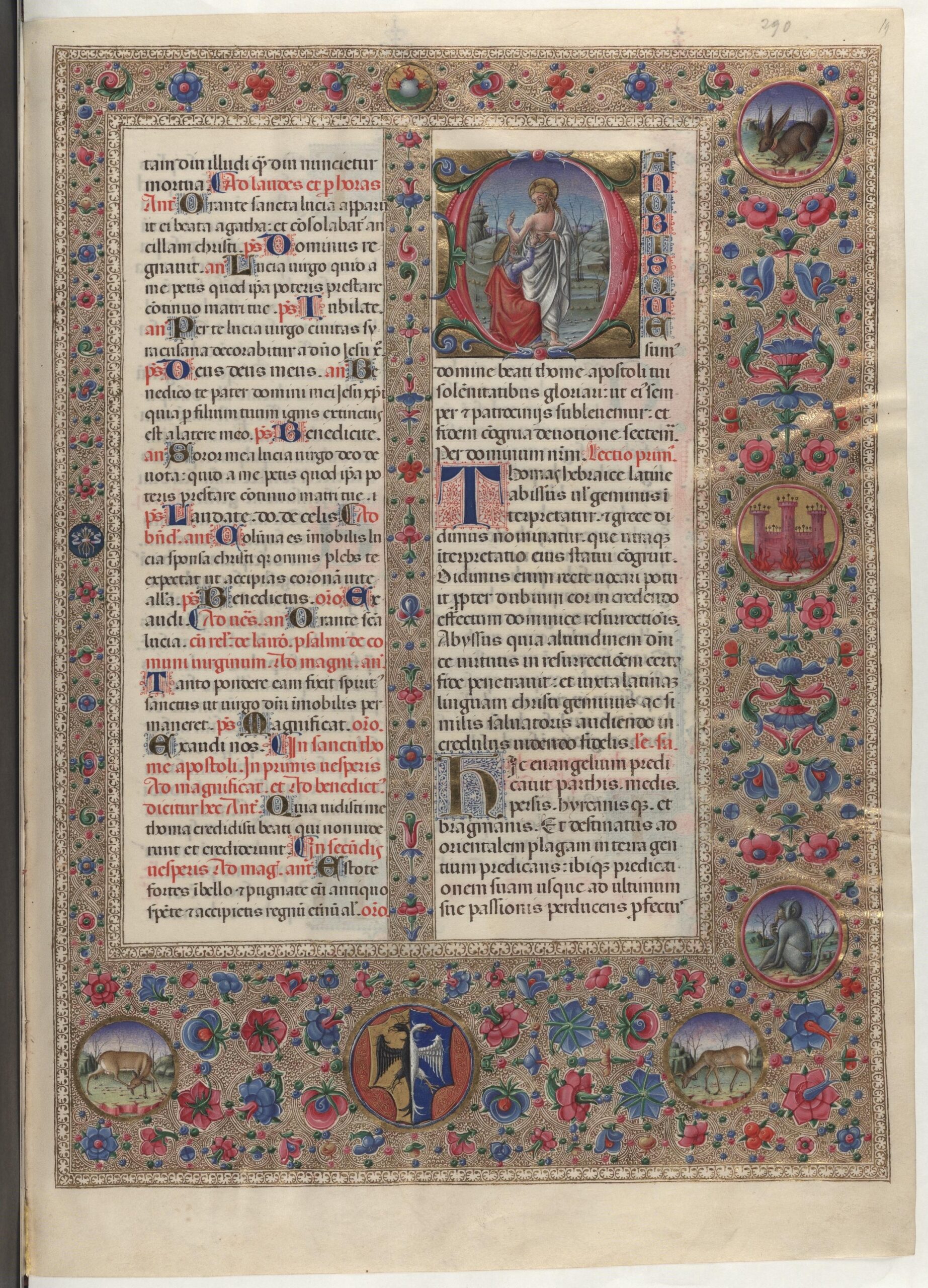The sumptuous miniated codex commissioned by Ercole I is one of those rare and precious objects desired by sovereigns as a demonstration of the power and prestige they achieved. Moreover, the ‘Breviary’ stands in continuity with the ‘Bible’ commissioned by Ercole’s predecessor and brother, Borso, between 1455 and 1461. The commission of the codex was completed in 1505 by his successor Alfonso I, as is evident from the payments and the inclusion of emblems referable to his son.
The Breviary (in Latin Breviarium Romanum) is a liturgical book used for daily personal prayer in which the ‘Canonical Hours’ mark the day through the recitation of prayers at certain times of the day and are different depending on the liturgical season. This Breviary consists of 491 miniated pages on recto and verso with figured initials, vignettes and marginal friezes as well as elaborate full-page miniatures, which introduced the different sections (Temporal, Salterio, Santorale and Comune Sanctorum). Unfortunately, these pages were removed and sold on the antiques market in the second half of the 19th century when, having abandoned the Estense Duchy forever, the last Duke Francesco V took it with him to Vienna.
The complex work of decoration was entrusted to three miniaturists, two of whom have been widely accepted by critics, while the name of the third is still debated. The first author identified is Matteo da Milano, who came to Ferrara from the Milanese court of Ludovico il Moro. His hand appears to be the most innovative, capable of finding an effective synthesis between the Lombard and Emilian painting styles. Tommaso da Modena is the second artist active in the decoration of the Breviary, his work, however, is still firmly tied to tradition. Critics propose identifying the third miniaturist with Giovanni Battista Cavalletto, a Bolognese artist of the Bentivoglio circle, as an alternative to Antonio Maria da Casanova, who is mentioned in the documents concerning the codex, but whose other works are unknown.
The manuscript pages are embellished with figured initials, vignettes, friezes with floral motifs, roundels with animals, and symbols of Ercole who commissioned the work and Alfonso I, who completed its execution. The decoration proposes a mature and contemporary language that looks to prints and the natural landscape to re-propose it in the miniature. On the verso of page 139, it is evident how the Duke’s name has been changed, from Ercole to Alfonso, to reflect the new owner of the codex. In the inner right-hand margin, Duke Alfonso I has his own coat of arms inserted – the arm coming out of the flames and holding an F – and the name “AFON/ SUS”, but he is unable to remove and completely change part of an inscription that still reads “DUX” and “SECU/ NDU/ S” a clear reference to the second Duke of Ferrara, Ercole I.
Following the Devolution of Ferrara, the Breviary was transferred to Modena and later left the city at the request of Duke Ercole III in 1800 to save it from the Napoleonic invasion. Finally, after 1859, the manuscript followed the last Duke Francesco V in his exile to Vienna, together with the famous ‘Borso’s Bible’ and the precious ‘Offiziolo Alfonsino’, later passing into the hands of first Francesco Ferdinando d’Austria d’Este and then the last Emperor Charles I. At the end of the First World War, the codex was located in 1929 in Lausanne, where Duchess Zita, widow of the Emperor, decided to sell it. Fortunately, the precious masterpiece was recognised by the famous bibliophile and antiquarian Tammaro De Marinis and subsequently purchased by the Italian government. Since 1939 it has been kept in the Biblioteca Estense Universitaria in Modena, while the precious miniated papers that were removed are kept in Zagreb at the Strossmayer Gallery.
Click on the link to access the browsable version of the Estense Digital Library: https://edl.beniculturali.it/beu/850016177
Persistent identifier Breviary of Ercole I: https://n2t.net/ark:/65666/v1/16177








